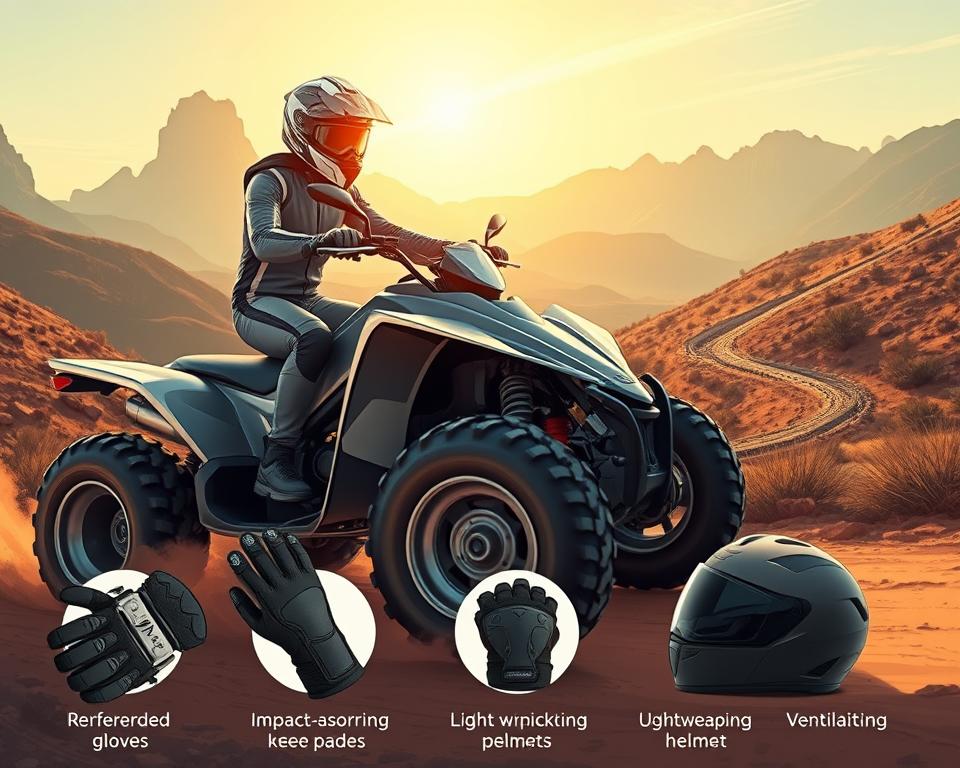How New Riders Can Avoid ATV/UTV Gear Selection Pitfalls
Are you aware that nearly 25% of new ATV and UTV owners face gear selection issues within their first year? Such data emphasizes how critical gear ratios are for novice riders. Beyond performance, proper gearing is a key safety factor. In this guide, we cover typical errors, upkeep tips, and pro side by side stuff recommendations for better trail experiences.
Essential Insights

- Knowing gear ratios is crucial for peak off-road power.
- Typical gear mistakes compromise safety on uneven ground.
- Routine care averts transmission breakdowns.
- Proper gear selection greatly enhances off-road riding experiences.
- Implementing ATV maintenance tips can prolong vehicle lifespan.
Understanding ATV and UTV Gear Ratios
Gear ratios are vital for the performance of ATVs and UTVs. They dictate how engine power translates into speed and torque. This controls how quickly you get up to speed and tow trailers. By picking specific ratios, you tailor your ride for drag, trail, or work.
Selecting proper gears unlocks engine potential. Excessively low gearing reduces hill-climbing pull. On the other hand, a high gear ratio can slow down acceleration, making it tough to speed up on straight paths.
Adjusting reduction influences handling in mud, sand, and rock. By adjusting gear ratios, riders can customize their vehicle’s performance. This ensures the machine operates efficiently, whether prioritizing speed or torque. Finding the sweet spot in gearing enhances ride quality and fuel economy.
Common Gearing Oversights for New ATV/UTV Owners
Correct gearing secures top output and trail safety. Many new owners overlook critical aspects of gear selection. Understanding the effects of wrong gear choices and selecting the right one for your terrain can greatly improve your ride. It also helps avoid issues.
Impact of Incorrect Gear Selection
Wrong ratios threaten stability and component life. Poor gear choice dampens speed, stresses brakes, and accelerates wear. These mishaps compromise safety for all on and off board. Using maintenance best practices wards off these hazards.
Choosing the Right Gear for Terrain
Different terrains need different gearing for efficient performance. Climbing requires low-end grunt from smaller ratios. To cover ground quickly, shift to higher ratios. In muddy or sandy conditions, choosing the right gear is essential for traction and stability. Recognizing terrain traits delivers safer, smoother rides.
The Importance of Proper ATV Maintenance
Routine upkeep ensures reliable performance. Adhering to care guides prevents sudden failures and enhances safety. A tailored service plan prioritizes drivetrain care.
Regular Inspection and Maintenance
A thorough inspection list catches troubles before they grow. Routinely examine gearbox teeth, brake pads, rubber, and belts. Routine checks lead to peak performance. Here are some critical inspection points to remember:
- Examine gear alignment and wear.
- Check for loose bolts or connections.
- Check master cylinder and calipers for leaks.
- Verify tire PSI and rubber life.
- Inspect battery terminals and cables for buildup.
Fluid Changes and Gear Health
Clean fluids keep transmissions and differentials happy. Frequent changes clear out contaminants. Pure coolant and oil lower temperatures and prolong service intervals. Adopting this routine preserves drivetrain health and trail readiness.
| Fluid Type | Recommended Change Interval | Benefits of Regular Change |
|---|---|---|
| Motor Oil | Every 50-100 hours | Reduces engine wear, enhances performance |
| Gear Oil | 100–200 operating hours | Smooths shifts and prevents pitting |
| Coolant | Annually | Prevents overheating, maintains optimal temperature |
Adhering to this schedule grants worry-free adventures. This makes every journey more enjoyable.
Common ATV Gear Shifting Problems
New ATV riders often face challenges with gear shifting. Developing fluid shift skills elevates trail enjoyment. It reduces frustration on the trails. Proper coordination of the throttle and clutch is key for control and avoiding shifting problems.
Learning to Shift Smoothly
Building graceful shift habits demands consistent effort. Start by getting to know your ATV engine’s rhythm. Smooth gear engagement reduces transmission stress and prevents issues. Blending throttle with clutch release ensures seamless shifts.
Practice shifting in a controlled setting until you’re confident. Focus on gentle throttle application during each gear change.
Recognizing Signs of Gear Issues
Spotting problems early prevents breakdowns. Listen for unusual sounds like grinding or popping, which may mean gears aren’t engaging right. Hard shifts or missed gears indicate trouble. Addressing issues promptly protects components and riders. Addressing ATV gear shifting problems properly maintains vehicle performance and boosts your confidence while riding.
Understanding UTV Transmission Issues
Transmission headaches are common; understanding them aids fixes. Frequent complaints include gears that pop out and strange whines. Below we break down common failures and the tools to troubleshoot them. Leveraging user-friendly diagnostic procedures.
Diagnosing Common Problems
Identifying symptoms early prevents bigger issues. Common issues include:
- Gears that pop out under load, risking accidents.
- Unusual sounds, such as grinding or whining, indicating mechanical damage.
- Signs of fluid seepage that threaten gearbox health.
Routine checks uncover faults early. It lets you fix faults before they worsen. Ignoring these signs can lead to expensive repairs and reduced performance.
Solutions for Troubleshooting UTV Transmissions
Fixing UTV transmission issues requires a systematic approach. Follow these steps for effective troubleshooting:
- Ensure gearbox fluid is at spec, then add if low.
- Inspect pan and seals for drips.
- Assess internal components for wear or chipping.
- Drive through each gear step-by-step and note any skips.
- Check OEM guides for model-specific repair advice.
Leveraging a proven guide speeds up repairs. Grasping drivetrain theory helps maintain your rig. This knowledge boosts lifespan and performance.
ATV Clutch Adjustments and Their Benefits
Proper ATV clutch adjustments are key to a great riding experience. Misadjusted clutches cause jerky shifts and rider irritation. Routine calibration refines clutch response and engagement.
Precision in gear changes is critical. Correctly calibrated clutches enable flawless transitions. That boosts throttle response and enjoyment in every gear.
Skipping clutch care leads to early failures and poor shifts. Regular tuning keeps shifts sharp and the motor lively. All riders benefit from clutch care to maintain top performance.
Mastering the Art of Gear Shifting
Becoming adept at shifts transforms your off-road sessions. Understanding drivetrain function and shift timing is crucial. Rookies need to practice gear timing. Consistent timing makes shifts effortless and more efficient.
Skillful shifting comes from drilling in diverse environments. Understanding when to shift gears based on terrain type enhances control and safety. Dropping a gear before a climb preserves torque and control.
- Drill slow shifts to master the clutch.
- Listen and feel each gear engagement.
- Step up to steeper, rougher trails as you improve.
Getting in sync with your ride ensures perfect shifts. Heed revs and shakes to know shift points. Such feedback tells you when to execute transitions. This natural touch produces fluid gear changes for maximum enjoyment.
Best Practices for UTV Gear Selector Problems
Managing UTV gear selector problems demands a proactive maintenance and diagnostic approach. Routine linkage reviews catch wear promptly. Learning proper lever use minimizes failures. Inspect link rods and fluid status as part of every service.
If you suspect a fault, inspect the lever assembly for bends or breaks. Clunks or rattles can signal a loose linkage. Minor tweaks typically fix selector snags. A routine plan stops small faults from growing.
Using a systematic approach, like documenting gear performance under different conditions, helps identify specific problems. These best practices not only extend the gear selector’s life but also make riding safer and more enjoyable.
Tips for Enhancing Gear Performance
Achieving top drivetrain function demands regular attention. Routine service boosts ATV efficiency. Verify oil levels, examine parts, and tweak calibrations. A simple inspection can prevent extensive damage and costly repairs.
Choosing the right gear ratios is essential for maximizing engine response and achieving a smoother ride. Understanding the terrain you will face allows you to select the appropriate ratios. It shapes your bike’s quickness and runway performance. Consulting reputable brands like American Off-Roads, which offer aftermarket modifications, can help with UTV performance enhancements.
Implementing gear performance tips in wheels, springs, and ballast optimization elevates function. These tweaks guarantee superior handling in rough conditions. You’ll notice more thrill and less stress on every trip. Implementing these strategies will allow riders to navigate with confidence while enjoying the thrill of the ride.
Wrapping It Up
Getting your gears right is the key to speed and security. Selecting proper ratios for each trail elevates your experience. Steering clear of rookie errors and picking wisely ensures safe, thrilling rides.
The importance of performance maintenance cannot be overstated. Routine inspections and care fend off failures and boost lifespan. Proper care boosts efficiency and keeps you safe in diverse environments.
Understanding gear selection and prioritizing maintenance leads to a more fulfilling experience for ATV/UTV fans. Embracing these tips sets the stage for countless epic journeys.
FAQ
What are the typical gear ratios for ATVs and UTVs?
Ratio specs differ greatly by manufacturer and use case. Typical ratios lie within the 3-to-5 range. Smaller ratios deliver grunt for trails and climbs. Taller ratios boost runway speed on level ground.
Signs of misgearing for different surfaces?
Using the wrong gear can lead to loss of control, excessive engine revving, or poor acceleration. Each terrain type—mud, sand, rock, or snow—requires specific gear selection for optimal performance.
Warning signs for upkeep on your off-road vehicle?
Pay attention to hard shifts, strange sounds, leaky fluid, or waning torque. Scheduling drivetrain inspections stops big failures.
Recommended fluid change intervals?
Aim for a fluid swap between 1,500–2,500 miles or annually, whichever comes first. Pure oils maintain smooth shifts and protect internals over time.
What techniques should I use for smooth gear shifting?
Sync your revs and clutch for seamless gear changes. Ease out the clutch as you roll on the throttle to align RPM and road speed.
How can I troubleshoot UTV transmission issues?
Start by checking for common problems like slipping gears or strange noises. Inspect the transmission fluid level and condition. Next, test-drive at varied speeds to see how it shifts.
Benefits of tuning your clutch?
Fine-tuned clutches deliver flawless shifts. An improperly set clutch can cause shifting difficulties and may lead to premature wear on transmission components.
Optimizing gears for varied ground?
Try different ratio setups and check out trusted upgrades from American Off-Roads. Scheduled service—linkage grease and oil changes—maintains top output.
What should I do if my UTV gear selector is malfunctioning?
Scheduled upkeep resolves most shifter faults. When the shifter binds, use the OEM troubleshooting procedures to find the root cause.
What common mistakes should new ATV/UTV owners avoid?
Beginners sometimes skip ratio learning, skip services, or stay in the wrong gear for conditions. Such errors cause subpar power delivery and increased accident risk.

